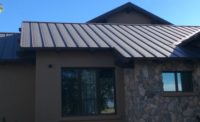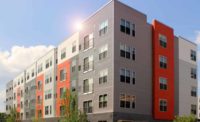The New Jersey Meadowlands Commission’s (NJMC) Center for Environmental and Scientific Education is a good example of how the commission has become a leader in green building design. Located in Lyndhurst, New Jersey on the edge of a 5,000-acre salt marsh about a mile from Manhattan, the center contains several classrooms, science labs, a multipurpose room, and it features a green building practices curriculum for the thousands of students from every educational level visiting the facility each year.
Adjacent to the center is the William D. McDowell Observatory—named for NJMC’s first executive director—which also was built to LEED standards…LEED Platinum, to be exact.
In fact, LEED certification was a central consideration in the development and design of the education building. For example, the NJMC landscape incorporates a nearby park into the design with sustainable landscaping featuring plants native to the region. Reduced water consumption was also successful thanks to infrared sensors on bathroom sinks, low-flow toilets and waterless urinals.
A 165-unit rooftop crystalline solar panel array was designed to generate electricity for the building’s power needs, and motion-sensitive lighting controls that automatically shut off lights when rooms are not in use were also installed. The 165 GE Energy PVp 200-MS solar units produce a peak maximum of 33,000 watts of electricity. The solar panels are attached to four sections of a standing-seam metal roof by brackets also made by GE Energy.
The standing-seam metal roof chosen was an Englert Series 2000 standing-seam metal roof, selected because “it met green building criteria and was aesthetically pleasing, the latter being a very important reason for the selection,” says Fredric A. Rosen, the Ridgefield, N.J.-based architect who designed the center. The bone-white roof meets emissivity and reflectivity requirements for ENERGY STAR approval, as well as qualifications for several LEED credits for energy savings, recyclability, reuse and local manufacturing. The coil used in rollforming the roofing material was manufactured at the Englert Inc. plant in nearby Perth Amboy, N.J., less than 25 miles away from the center and well within the 500-mile (800-km) radius LEED requires for manufacturing.
“This is not the kind of facility where you would use asphalt shingles,” Rosen explains, praising the roofing contractor, Cipollini Roofing & Construction of Dover, N.J.
The 18-inch-wide standing-seam panels and the solar array “appear to be working very well,” says Ralph Venturini, the Meadowland Commission’s on-staff project manager for design/build on the center. The roof’s ability to earn LEED credits for energy savings, recyclability and local manufacturing were key considerations for choosing metal, he adds.
The designers incorporated Solatube solar tubes in the ceiling to allow natural light into the center and to reduce reliance on traditional power sources. Energy-efficient heating, ventilation and air-conditioning systems—as well as a fume hood in chemistry lab—were specified to maintain indoor environmental quality.
Sustainable Observations
Even the William D. McDowell Observatory was designed to meet LEED standards.
The observatory’s state-of-the-art telescope, contained within a 19.6-foot (6-m) retractable dome, has special filters designed to help minimize the effects of the area’s pollution. This research-grade instrument is equipped with tools such as specialized cameras to photograph various astronomical objects; a photometer to measure the brightness of stars and study how they vary over time; and a spectroscope to analyze the wavelengths of light to determine the chemical composition of light-emitting objects.
The observatory earns LEED credits for recyclability and reuse because its dome is made from Galvalume rollformed material. Manufactured by Ash-Dome at its Plainfield, Ill. plant, the dome is made of panels measuring 16 inches (406 mm) at their base and tapering upward to the top. The dome’s up-and-over style shutter system allows the astronomer to view any portion of the sky through a protected viewing aperture. The shutter also keeps wind turbulence in the observatory to a minimum.
The standing seam metal is used in the classroom roofs that face south to capitalize on sunlight hitting the solar panels and the Galvalume in the observatory dome were helpful in the quest to achieve the Platinum rating.









